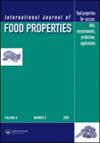Quality of Cuttlefish as Affected by Different Thawing Methods
IF 3.1
3区 农林科学
Q2 FOOD SCIENCE & TECHNOLOGY
引用次数: 9
Abstract
ABSTRACT To investigate the effect of different thawing methods on the quality of frozen cuttlefish, six different thawing methods were used: hydrostatic thawing (HT), flowing water thawing (FWT), saline solution thawing (SWT), ultrasonic water thawing (UWT), microwave thawing (MT), and 4°C refrigerator thawing (RT). In this study, the water retention (thawing loss rate, centrifugal loss rate, and cooking loss), pH value, malondialdehyde content, TVB-N value, and sulfhydryl content were measured to evaluate the quality after thawing. Protein secondary structure was measured using attenuated total reflection Fourier transform infrared (ATR-FTIR) spectroscopy, protein tertiary structure was obtained by fluorescence spectroscopy and water migration was determined using low-field NMR spectroscopy. The results showed that the microwave thawing time was the shortest, but the water holding capacity after thawing was the worst, and the TVB-N content was the highest at 14.31 mg/100 g. Ultrasonic thawing led to the best water holding capacity, but ultrasound promoted the oxidation of protein and fat. Microscopic observation showed that the muscle fiber bundles in the saline solution thawing samples were compactly arranged and intact, with minimal gaps. The samples thawed in saline solution had the highest hardness and chewiness. The results of comprehensive analysis showed that saline solution thawing and ultrasonic water thawing are more suitable for thawing cuttlefish, and this study provides some theoretical basis for the selection of thawing methods in the actual production of cuttlefish.不同解冻方法对墨鱼品质的影响
摘要为研究不同解冻方法对冷冻墨鱼品质的影响,采用静水压解冻(HT)、流水解冻(FWT)、盐水解冻(SWT)、超声波水解冻(UWT)、微波解冻(MT)和4℃冰箱解冻(RT) 6种不同的解冻方法。本研究通过测定保水率(解冻损失率、离心损失率和蒸煮损失率)、pH值、丙二醛含量、TVB-N值和巯基含量来评价解冻后的质量。用衰减全反射傅立叶变换红外(ATR-FTIR)光谱测定蛋白质二级结构,荧光光谱测定蛋白质三级结构,低场核磁共振光谱测定水迁移。结果表明,微波解冻时间最短,但解冻后保水能力最差,TVB-N含量最高,为14.31 mg/100 g。超声波解冻的保水能力最好,但促进了蛋白质和脂肪的氧化。显微镜观察发现,盐水解冻样品的肌纤维束排列紧凑、完整,间隙极小。在盐水中解冻的样品硬度和嚼劲最高。综合分析结果表明,盐水溶液解冻和超声波水解冻更适合于解冻墨鱼,本研究为实际生产墨鱼中解冻方法的选择提供了一定的理论依据。
本文章由计算机程序翻译,如有差异,请以英文原文为准。
求助全文
约1分钟内获得全文
求助全文
来源期刊

International Journal of Food Properties
工程技术-食品科技
CiteScore
5.20
自引率
3.40%
发文量
167
审稿时长
4.3 months
期刊介绍:
The International Journal of Food Properties publishes original research papers devoted to all scientific and applied aspects of food properties. The emphasis is on measurement methods, development of standards, and data on food properties, predictions, and applications.
The International Journal of Food Properties brings together the widely scattered research in the area of food properties and provides an international forum for scientists and technologists for rapid dissemination of their research results, ideas, and knowledge. Other features include review articles, book reviews, letters to the editor, conference papers, news, and commercial advertisements.
文献相关原料
| 公司名称 | 产品信息 | 采购帮参考价格 |
|---|
 求助内容:
求助内容: 应助结果提醒方式:
应助结果提醒方式:


